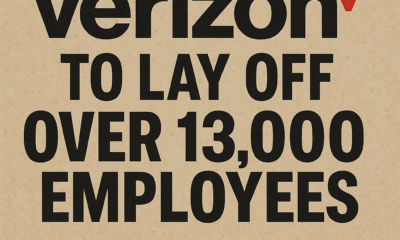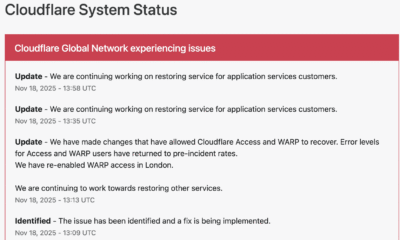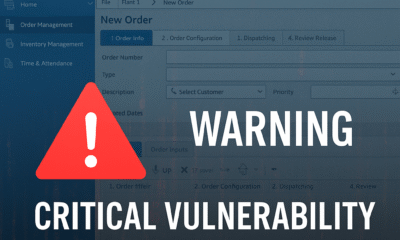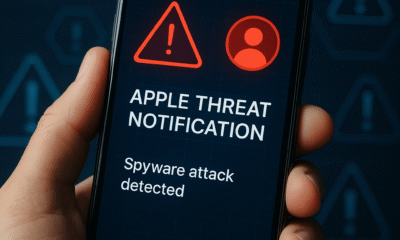data breaches
Wi-Fi Hack at 19 UK Railway Stations Displays Terror Threats: A Wake-Up Call for Cybersecurity in Public Transport
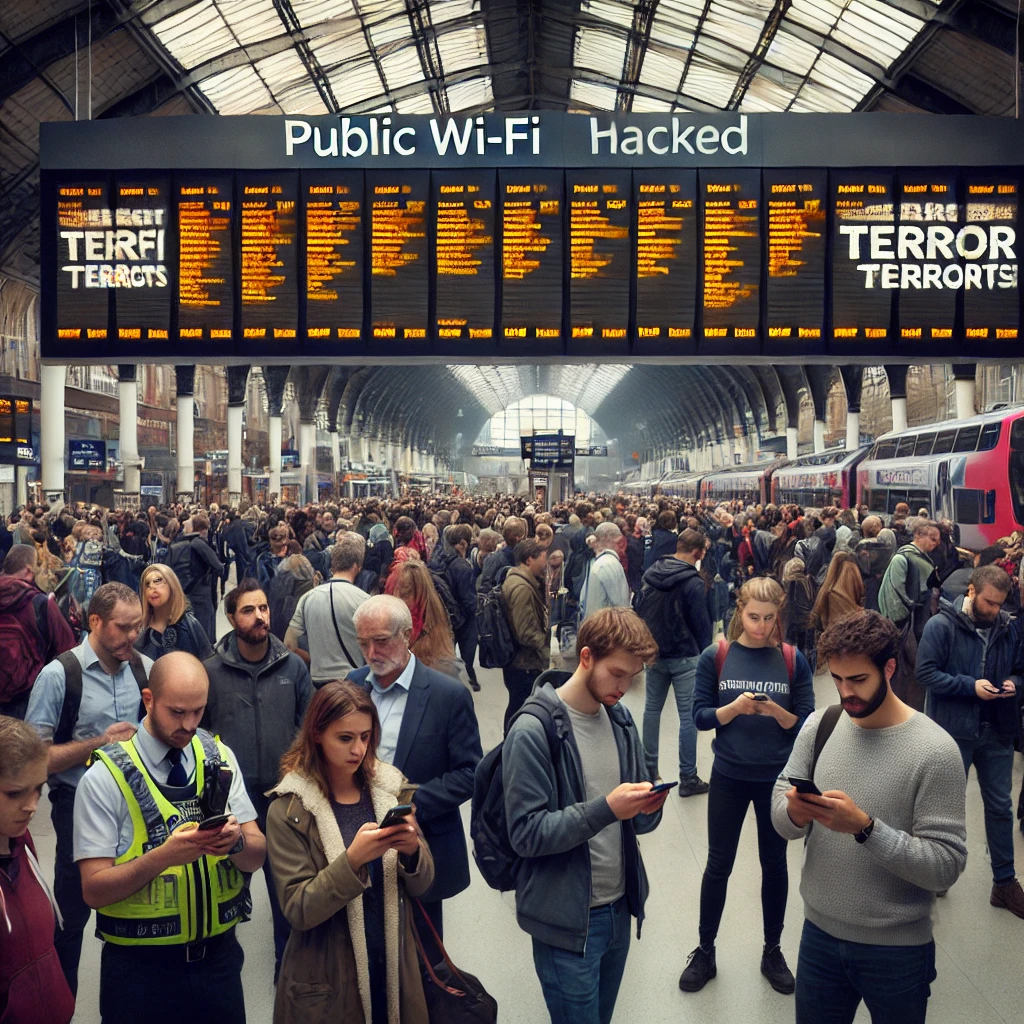
In a chilling demonstration of the growing cybersecurity vulnerabilities in public infrastructure, hackers infiltrated the Wi-Fi systems of 19 major railway stations across the UK, displaying disturbing messages about terror attacks. The hack, which affected thousands of passengers using station Wi-Fi networks, has sparked widespread concern over the safety and security of public transportation systems in the digital age.
The cyberattack, which occurred early last week, sent shockwaves through the country, as the messages, reportedly warning of imminent terror threats, appeared on devices connected to the compromised networks. While no actual physical threat was confirmed, the incident has raised urgent questions about the cybersecurity resilience of critical infrastructure, the preparedness of authorities, and the potential for similar attacks to cause panic or even disrupt national security.
The Attack: A Multi-Station Infiltration
The cyberattack was first detected when passengers using the free public Wi-Fi at London’s Euston Station reported seeing unsettling messages pop up on their devices. The warnings claimed that there would be a series of coordinated terror attacks across various transportation hubs in the UK. Initially dismissed as a potential hoax or isolated incident, it soon became clear that the messages were not random as similar alerts surfaced at other stations.
Over the next few hours, reports came in from passengers at 18 other railway stations, including high-traffic locations like Manchester Piccadilly, Birmingham New Street, and Glasgow Central, all receiving the same terrifying alerts. The messages were not only displayed on smartphones and laptops connected to the stations’ Wi-Fi networks but also, in some instances, on public display monitors used to provide travel information.
The hack was particularly concerning because of the scale and coordination involved. Hackers were able to infiltrate multiple independent Wi-Fi networks across different stations simultaneously, suggesting a well-planned and highly sophisticated attack. The fact that the hackers chose to display messages about terrorism—a topic already sensitive in the UK—exacerbated the sense of fear and uncertainty among passengers.
Public Reaction: Panic and Confusion
The immediate reaction to the cyberattack was one of panic and confusion. Passengers, already anxious about the potential for real-life terrorist threats, were understandably alarmed by the messages. Some abandoned their journeys altogether, fearing that the threats might be real, while others took to social media to express their concerns and seek information.
One passenger, traveling through Manchester Piccadilly, described the moment they saw the message on their phone: “At first, I thought it was just spam, but when I saw other people on the train panicking and checking their phones, I realized something was very wrong. It felt like a scene from a movie—like something terrible was about to happen.”
The station staff and authorities were quickly overwhelmed by inquiries from concerned passengers. Although station management and police moved swiftly to assure the public that there were no verified threats of terror attacks, the damage had already been done. For several hours, confusion reigned as passengers waited for official confirmation that the messages were part of a cyberattack and not indicative of an actual security threat.
Cybersecurity Concerns: A Vulnerable Network
As investigations into the attack began, cybersecurity experts were quick to point out the vulnerabilities in the public Wi-Fi networks used by UK railway stations. While free Wi-Fi has become a standard amenity in most transportation hubs, these networks are often seen as “soft targets” for hackers due to their widespread use and relatively weak security protocols.
Most public Wi-Fi networks, including those in railway stations, are designed for accessibility and convenience rather than security. While convenient for passengers, these networks often lack robust encryption and can be easily infiltrated by cybercriminals looking to distribute malware, steal personal data, or, as in this case, spread disruptive and alarming messages.
The ease with which the hackers were able to breach multiple networks simultaneously has led to serious questions about how secure public transportation systems are from cyberattacks. If hackers were able to display terror threats with relative ease, what’s to stop them from launching more damaging attacks, such as shutting down ticketing systems, disrupting train schedules, or even interfering with critical railway infrastructure?
According to cybersecurity analysts, this particular attack appeared to be a “man-in-the-middle” attack, where hackers intercept communications between a user’s device and the public Wi-Fi network. By exploiting vulnerabilities in the Wi-Fi routers and software, they were able to inject their own content—in this case, terror threat messages—into the data stream, effectively hijacking the network.
Government and Law Enforcement Response
The UK government, along with law enforcement and cybersecurity agencies, has launched a full-scale investigation into the attack. The National Cyber Security Centre (NCSC), in coordination with the British Transport Police, has been tasked with identifying the perpetrators and assessing the full extent of the breach. Initial findings suggest that the hackers may have operated from outside the UK, although the exact origin of the attack is still being determined.
A spokesperson for the NCSC described the incident as “a significant breach of public infrastructure” and emphasized that no system is immune to cyberattacks. “This attack highlights the growing threats facing public infrastructure in the digital age. While no physical harm was done, the psychological impact and potential for widespread panic cannot be underestimated.”
In response to the incident, railway operators have temporarily suspended public Wi-Fi services at all affected stations while security upgrades are implemented. Authorities have also urged passengers to be cautious when using public Wi-Fi networks and to avoid accessing sensitive information, such as online banking, when connected to unsecured networks.
The UK government has been proactive in addressing the nation’s cybersecurity posture in recent years, but this attack demonstrates that more needs to be done to protect critical public infrastructure from increasingly sophisticated cyberattacks. With the UK heavily reliant on its transportation network, ensuring the cybersecurity of these systems has become an urgent national priority.
A Growing Threat to Public Infrastructure
The attack on UK railway stations is the latest in a string of cyberattacks targeting public infrastructure around the world. In recent years, hackers have increasingly turned their attention to public services such as transportation, healthcare, and utilities, recognizing the potential to cause widespread disruption.
In 2021, a ransomware attack on the Colonial Pipeline in the U.S. disrupted fuel supplies across the eastern United States, demonstrating how vulnerable critical infrastructure can be. Similarly, attacks on public transportation systems have become more common. In 2020, San Francisco’s Bay Area Rapid Transit (BART) system experienced a cyberattack that disrupted fare payments, while in 2023, an attack on New York’s Metropolitan Transportation Authority (MTA) exposed vulnerabilities in its systems.
These incidents highlight the evolving nature of cyber threats and the need for greater investment in cybersecurity. Public infrastructure, often reliant on outdated systems and fragmented networks, presents an attractive target for hackers seeking to sow chaos or exploit vulnerabilities for financial gain.
The Future of Cybersecurity in Transportation
The Wi-Fi hack at 19 UK railway stations serves as a wake-up call for public transportation operators, government officials, and cybersecurity experts. As transportation systems become more connected and reliant on digital networks, the potential for cyberattacks will only grow. Ensuring the cybersecurity of these systems is no longer a secondary concern but an urgent priority.
Moving forward, experts recommend that public transportation authorities implement stronger encryption protocols for public Wi-Fi networks and adopt more advanced cybersecurity measures to detect and mitigate potential threats. This includes regularly updating and patching systems, conducting penetration testing to identify vulnerabilities, and educating staff and passengers about cybersecurity risks.
While the immediate crisis caused by the Wi-Fi hack has subsided, the long-term implications of the attack will continue to be felt. For many passengers, the incident has shattered their sense of security when using public transportation. It has also underscored the importance of safeguarding not just physical infrastructure, but the digital systems that increasingly underpin modern life.
As investigations into the cyberattack continue, one thing is clear: the future of public transportation is digital, and with that digital future comes an increased responsibility to protect passengers from both physical and virtual threats.
data breaches
Cloudflare Outage Disrupts Global Internet — Company Restores Services After Major Traffic Spike

November 18, 2025 — MAG212NEWS
A significant outage at Cloudflare, one of the world’s leading internet infrastructure providers, caused widespread disruptions across major websites and online services on Tuesday. The incident, which began mid-morning GMT, temporarily affected access to platforms including ChatGPT, X (formerly Twitter), and numerous business, government, and educational services that rely on Cloudflare’s network.
According to Cloudflare, the outage was triggered by a sudden spike in “unusual traffic” flowing into one of its core services. The surge caused internal components to return 500-series error messages, leaving users unable to access services across regions in Europe, the Middle East, Asia, and North America.
Impact Across the Web
Because Cloudflare provides DNS, CDN, DDoS mitigation, and security services for millions of domains — powering an estimated 20% of global web traffic — the outage had swift and wide-reaching effects.
Users reported:
- Website loading failures
- “Internal Server Error” and “Bad Gateway” messages
- Slowdowns on major social platforms
- Inaccessibility of online tools, APIs, and third-party authentication services
The outage also briefly disrupted Cloudflare’s own customer-support portal, highlighting the interconnected nature of the company’s service ecosystem.
Cloudflare’s Response and Restoration
Cloudflare responded within minutes, publishing updates on its official status page and confirming that engineering teams were investigating the anomaly.
The company took the following steps to restore operations:
1. Rapid Detection and Acknowledgement
Cloudflare engineers identified elevated error rates tied to an internal service degradation. Public communications were issued to confirm the outage and reassure customers.
2. Isolating the Affected Systems
To contain the disruption, Cloudflare temporarily disabled or modified specific services in impacted regions. Notably, the company deactivated its WARP secure-connection service for users in London to stabilize network behavior while the fix was deployed.
3. Implementing Targeted Fixes
Technical teams rolled out configuration changes to Cloudflare Access and WARP, which successfully reduced error rates and restored normal traffic flow. Services were gradually re-enabled once systems were verified stable.
4. Ongoing Root-Cause Investigation
While the unusual-traffic spike remains the confirmed trigger, Cloudflare stated that a full internal analysis is underway to determine the exact source and prevent a recurrence.
By early afternoon UTC, Cloudflare confirmed that systems had returned to pre-incident performance levels, and affected services worldwide began functioning normally.
Why This Matters
Tuesday’s outage underscores a critical truth about modern internet architecture: a handful of infrastructure companies underpin a massive portion of global online activity. When one of them experiences instability — even briefly — the ripple effects are immediate and worldwide.
For businesses, schools, governments, and content creators, the incident is a reminder of the importance of:
- Redundant DNS/CDN providers
- Disaster-recovery and failover plans
- Clear communication protocols during service outages
- Vendor-dependency risk assessments
Cloudflare emphasized that no evidence currently points to a cyberattack, though the nature of the traffic spike remains under investigation.
Looking Ahead
As Cloudflare completes its post-incident review, the company is expected to provide a detailed breakdown of the technical root cause and outline steps to harden its infrastructure. Given Cloudflare’s central role in global internet stability, analysts say the findings will be watched closely by governments, cybersecurity professionals, and enterprise clients.
For now, services are restored — but the outage serves as a powerful reminder of how interconnected and vulnerable the global web can be.
data breaches
Cloudflare Outage Analysis: Systemic Failure in Edge Challenge Mechanism Halts Global Traffic
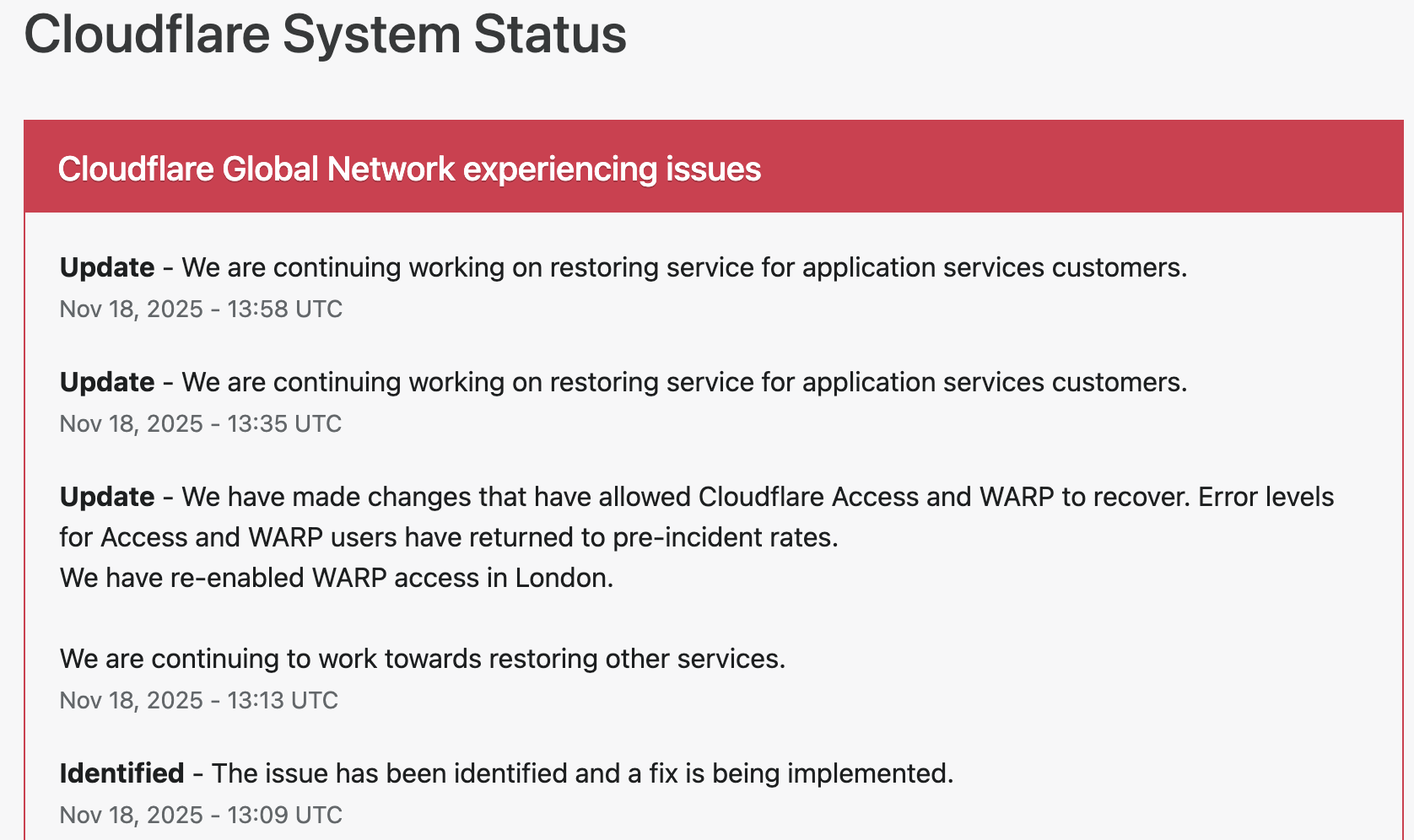
SAN FRANCISCO, CA — A widespread disruption across major internet services, including AI platform ChatGPT and social media giant X (formerly Twitter), has drawn critical attention to the stability of core internet infrastructure. The cause traces back to a major service degradation at Cloudflare, the dominant content delivery network (CDN) and DDoS mitigation provider. Users attempting to access affected sites were met with an opaque, yet telling, error message: “Please unblock challenges.cloudflare.com to proceed.”
This incident was not a simple server crash but a systemic failure within the crucial Web Application Firewall (WAF) and bot management pipeline, resulting in a cascade of HTTP 5xx errors that effectively severed client-server connections for legitimate users.
The Mechanism of Failure: challenges.cloudflare.com
The error message observed globally points directly to a malfunction in Cloudflare’s automated challenge system. The subdomain challenges.cloudflare.com is central to the company’s security and bot defense strategy, acting as an intermediate validation step for traffic suspected of being malicious (bots, scrapers, or DDoS attacks).
This validation typically involves:
- Browser Integrity Check (BIC): A non-invasive test ensuring the client browser is legitimate.
- Managed Challenge: A dynamic, non-interactive proof-of-work check.
- Interactive Challenge (CAPTCHA): A final, user-facing verification mechanism.
In a healthy system, a user passing through Cloudflare’s edge network is either immediately granted access or temporarily routed to this challenge page for verification.
During the outage, however, the Challenge Logic itself appears to have failed at the edge of Cloudflare’s network. When the system was invoked (likely due to high load or a misconfiguration), the expected security response—a functional challenge page—returned an internal server error (a 500-level status code). This meant:
- The Request Loop: Legitimate traffic was correctly flagged for a challenge, but the server hosting the challenge mechanism failed to process or render the page correctly.
- The
HTTP 500Cascade: Instead of displaying the challenge, the Cloudflare edge server returned a “500 Internal Server Error” to the client, sometimes obfuscated by the text prompt to “unblock” the challenges domain. This effectively created a dead end, blocking authenticated users from proceeding to the origin server (e.g., OpenAI’s backend for ChatGPT).
Technical Impact on Global Services
The fallout underscored the concentration risk inherent in modern web architecture. As a reverse proxy, Cloudflare sits between the end-user and the origin server for a vast percentage of the internet.
For services like ChatGPT, which rely heavily on fast, secure, and authenticated API calls and constant data exchange, the WAF failure introduced severe latency and outright connection refusal. A failure in Cloudflare’s global network meant that fundamental features such as DNS resolution, TLS termination, and request routing were compromised, leading to:
- API Timeouts: Applications utilizing Cloudflare’s API for configuration or deployment experienced critical failures.
- Widespread Service Degradation: The systemic 5xx errors at the L7 (Application Layer) caused services to appear “down,” even if the underlying compute resources and databases of the origin servers remained fully operational.
Cloudflare’s official status updates confirmed they were investigating an issue impacting “multiple customers: Widespread 500 errors, Cloudflare Dashboard and API also failing.” While the exact trigger was later traced to an internal platform issue (in some historical Cloudflare incidents, this has been a BGP routing error or a misconfigured firewall rule pushed globally), the user-facing symptom highlighted the fragility of relying on a single third-party for security and content delivery on a global scale.
Mitigation and the Single Point of Failure
While Cloudflare teams worked to roll back configuration changes and isolate the fault domain, the incident renews discussion on the “single point of failure” doctrine. When a critical intermediary layer—responsible for security, routing, and caching—experiences a core logic failure, the entire digital economy resting on it is exposed.
Engineers and site reliability teams are now expected to further scrutinize multi-CDN and multi-cloud strategies, ensuring that critical application traffic paths are not entirely dependent on a single third-party’s edge infrastructure, a practice often challenging due to cost and operational complexity. The “unblock challenges” error serves as a stark reminder of the technical chasm between a user’s browser and the complex, interconnected security apparatus that underpins the modern web.
data breaches
Manufacturing Software at Risk from CVE-2025-5086 Exploit

Dassault Systèmes patches severe vulnerability in Apriso manufacturing software that could let attackers bypass authentication and compromise factories worldwide.
A newly disclosed flaw, tracked as CVE-2025-5086, poses a major security risk to manufacturers using Dassault Systèmes’ DELMIA Apriso platform. The bug could allow unauthenticated attackers to seize control of production environments, prompting urgent patching from the vendor and warnings from cybersecurity experts.
A critical vulnerability in DELMIA Apriso, a manufacturing execution system used by global industries, could let hackers bypass authentication and gain full access to sensitive production data, according to a security advisory published this week.
Dassault Systèmes confirmed the flaw, designated CVE-2025-5086, affects multiple versions of Apriso and scored 9.8 on the CVSS scale, placing it in the “critical” category. Researchers said the issue stems from improper authentication handling that allows remote attackers to execute privileged actions without valid credentials.
The company has released security updates and urged immediate deployment, warning that unpatched systems could become prime targets for industrial espionage or sabotage. The flaw is particularly alarming because Apriso integrates with enterprise resource planning (ERP), supply chain, and industrial control systems, giving attackers a potential foothold in critical infrastructure.
- “This is the kind of vulnerability that keeps CISOs awake at night,” said Maria Lopez, industrial cybersecurity analyst at Kaspersky ICS CERT. “If exploited, it could shut down production lines or manipulate output, creating enormous financial and safety risks.”
- “Manufacturing software has historically lagged behind IT security practices, making these flaws highly attractive to threat actors,” noted James Patel, senior researcher at SANS Institute.
- El Mostafa Ouchen, cybersecurity author, told MAG212News: “This case shows why manufacturing execution systems must adopt zero-trust principles. Attackers know that compromising production software can ripple across supply chains and economies.”
- “We are actively working with customers and partners to ensure systems are secured,” Dassault Systèmes said in a statement. “Patches and mitigations have been released, and we strongly recommend immediate updates.”
Technical Analysis
The flaw resides in Apriso’s authentication module. Improper input validation in login requests allows attackers to bypass session verification, enabling arbitrary code execution with administrative privileges. Successful exploitation could:
- Access or modify production databases.
- Inject malicious instructions into factory automation workflows.
- Escalate attacks into connected ERP and PLM systems.
Mitigations include applying vendor patches, segmenting Apriso servers from external networks, enforcing MFA on supporting infrastructure, and monitoring for abnormal authentication attempts.
Impact & Response
Organizations in automotive, aerospace, and logistics sectors are particularly exposed. Exploited at scale, the vulnerability could cause production delays, supply chain disruptions, and theft of intellectual property. Security teams are advised to scan their environments, apply updates, and coordinate incident response planning.
Background
This disclosure follows a string of high-severity flaws in industrial and operational technology (OT) software, including vulnerabilities in Siemens’ TIA Portal and Rockwell Automation controllers. Experts warn that adversaries—ranging from ransomware gangs to state-sponsored groups—are increasingly focusing on OT targets due to their high-value disruption potential.
Conclusion
The CVE-2025-5086 flaw underscores the urgency for manufacturers to prioritize cybersecurity in factory software. As digital transformation accelerates, securing industrial platforms like Apriso will be critical to ensuring business continuity and protecting global supply chains.



